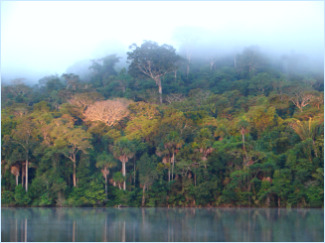
- Home
Articles

New advance in the study of Alzheimer's disease
Researchers at UAB and University of Stockholm have created a computer modelling of the structural malfunctioning of the ApoE4 protein when it enters into contact with the Amyloid beta molecule, the main cause of Alzheimer's disease. The research, published in PLoS...


Genome sequencing of three parasitoid wasps
An international consortium of scientists, including UAB researcher Deodoro Oliveira, have sequenced the genome of three species of parasitoid wasps of the genus Nasonia. The research offers new basic information on the genetic mechanisms of evolution. It is also of great importance...

A Second Hydrocarbon Boom Threatens the Peruvian Amazon
A rapid and unprecedented proliferation of oil and gas concessions threatens the megadiverse Peruvian Amazon. The amount of area leased is on track to reach around 70% of the region, threatening biodiversity and indigenous people. This is one of the central...


Environment and peace: European research under the direction of ICTA
The European research project CLICO -Climate Change, Water Conflict and Human Security- devoted to the study of climate change and its social dimensions begins in February with conferences that take place from 25 to 27 February in ...

The coordinating properties of metallothioneins in C. elegans
A research team made up of chemists of the UAB and biologists of the UB has studied the metallothionein system of the nematode Caenorhabditis elegans, a model organism in molecular biology. Although metallothioneins have been related to different...

Evolution could be predictable
Clines are trends in a morphological variation due to environmental influences. In Drosophila flies, one of the known clines is the size of their wings depending on latitude. The study of the American populations of Drosophila suboscura, carried out by a group of UAB geneticists, has led to a...

A new regenerable biocomponent for biosensing?
Biosensor performance and specificity strongly depends on the successful functionalisation of the sensing surface with appropriate capture biocomponents. A variety of bio-functionalisation strategies have been described to date, ranging from simple and fast random physisorption...

- 1
- 2
- 3
- 4
- 5
- 6
- 7
- 8
- 9
- 10
- 11
- 12
- 13
- 14
- 15
- 16
- 17
- 18
- 19
- 20
- 21
- 22
- 23
- 24
- 25
- 26
- 27
- 28
- 29
- 30
- 31
- 32
- 33
- 34
- 35
- 36
- 37
- 38
- 39
- 40
- 41
- 42
- 43
- 44
- 45
- 46
- 47
- 48
- 49
- 50
- 51
- 52
- 53
- 54
- 55
- 56
- 57
- 58
- 59
- 60
- 61
- 62
- 63
- 64
- 65
- 66
- 67
- 68
- 69
- 70
- 71
- 72
- 73
- 74
- 75
- 76
- 77
- 78
- 79
- 80
- 81
- 82
- 83
- 84
- 85
- 86
- 87
- 88
- 89
- 90
- 91
- 92
- 93
- 94
- 95
- 96
- 97
- 98
- 99
- 100
- 101
- 102
- 103
- 104
- 105
- 106
- 107
- 108
- 109
- 110
- 111
- 112
- 113
- 114
- 115
- 116
- 117
- 118
- 119
- 120
- 121
- 122
- 123
- 124
- 125
- 126
- 127
- 128
- 129
- 130
- 131
- 132
- 133
- 134
- 135
- 136
- 137
- 138
- 139
- 140
- 141
- 142
- 143
- 144
- 145
- 146
- 147
- 148
- 149
- 150
- 151
- 152
- 153
- 154
- 155
- 156
- 157
- 158
- 159
- 160
- 161
- 162
- 163
- 164
- 165
- 166
- 167
- 168
- 169
- 170
- 171
- 172
- 173
- 174
- 175
- 176
- 177
- 178
- 179
- 180
- 181
- 182
- 183
- 184
- 185
- 186
- 187
- 188
- 189
- 190
- 191
- 192
- 193
- 194
- 195
- 196
- 197
- 198
- 199
- 200
- 201

